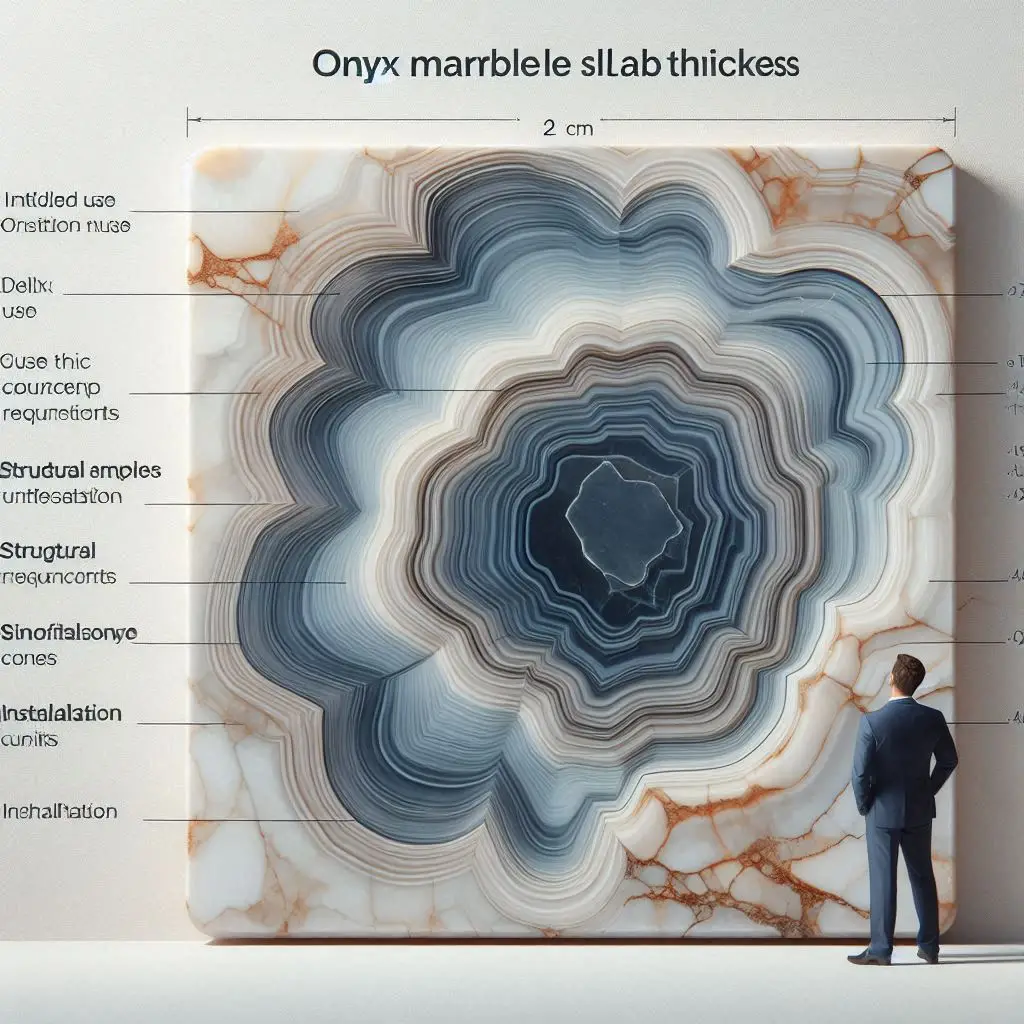
Onyx marble slab thickness
I want to talk about Onyx marble slab thickness.
The slab thickness of onyx marble is an important factor that affects this beautiful natural stone's appearance as well as its use. Several elements, such as the intended use, desired visual impacts, structural requirements, installation concerns, and budgetary limits, influence the decision between thinner (2 cm) and thicker (3 cm) slabs. By choosing the right thickness for each particular use case, onyx marble's distinctive beauty and translucency may be maximized whether it is used for floors, walls, or counters. In the end, choosing the thickness of an onyx marble slab with care and consideration guarantees that the stone will fulfill the design intent and provide enduring performance and pleasure.
As previously said, there are other factors to take into account than only appearance and use when determining the thickness of onyx marble slabs. It includes continuing upkeep, stylistic flexibility, and the unique regional characteristics of the stone. Thick slabs provide more strength and longevity, while thinner slabs highlight the full translucency of onyx marble. To ensure that the selected thickness fits the functional requirements of the intended use and smoothly integrates with the overall vision for the space, it should be decided upon in conjunction with other design and practical factors. A harmonic balance between beauty and utility is achieved by using the proper thickness of onyx marble to create a feature wall or an opulent countertop.
Beautiful natural stone onyx marble is well-known for its distinct and alluring look. This kind of metamorphic rock is distinguished by its transparent qualities, which let light through and provide an enthralling visual spectacle. The visual appeal and practicality of onyx marble slabs are greatly influenced by their thickness, which is an important factor.
Slabs of onyx marble come in a range of thicknesses, and the thickness is a major factor in how long-lasting, versatile, and effective the material is overall. Onyx marble slabs are normally offered in thicknesses between 2 and 3 cm, although bespoke thicknesses can also be possible based on the supplier and the particulars of the project.
The intended use is one of the main factors to take into account when selecting the thickness of onyx marble slabs. For instance, since they are easier to install and have a lower weight, thinner slabs (2 cm) are often used for ornamental components, backsplashes, and wall cladding. For worktops, floors, and other high-traffic areas where durability is crucial, thicker slabs (3 cm) are often used.
Because onyx marble is transparent, light may pass through it, adding to its aesthetic appeal. The degree of translucency and strength of the visual effects produced by backlit applications may be influenced by the thickness of the slab. More light may seep through thinner slabs, bringing out the color and veining in a more striking and lively way. The thickness of onyx marble slabs directly affects their strength and longevity in terms of structural integrity; in contrast, thicker slabs may have a more muted translucency but provide improved strength and resilience. Because thicker slabs are often stronger and less likely to shatter, they are appropriate for applications where a greater degree of resistance to wear and strain is required. For example, a countertop made of 3 cm onyx marble is more resilient to chipping and the impact of heavy things than one that is thinner.
The right thickness for onyx marble slabs depends on installation factors as well. In the design and installation process, the total weight of the stone should be taken into consideration, since thicker slabs could need more support. In order to guarantee that the thickness selected is in line with the project's structural specifications, contractors and designers must work together.
An additional consideration that may impact the choice of onyx marble slab thickness is cost. Because of the additional material and labor expenses involved in extraction, shipment, and manufacture, thicker slabs often fetch a higher price. Thus, the best thickness for a particular project may depend in part on financial considerations.
In addition to application and structural integrity, onyx marble slab upkeep and care are important factors in figuring out the perfect thickness. Because of their greater durability, thicker slabs can withstand normal wear and tear better. They are less vulnerable to damage from collision or heavy items and can endure the everyday rigors of high-traffic regions. Therefore, thicker onyx marble slabs are a useful option for areas that need to look beautiful for a long time but yet need less upkeep.
While thinner slabs are beautiful in certain settings, they may need to be handled more carefully to avoid chipping or breaking. A thicker slab becomes both a practical and aesthetic need in locations where the stone is exposed to high usage, such kitchen counters or busy corridors. In order to guarantee lifespan and simplicity of maintenance, homeowners and designers must carefully evaluate the lifestyle and usage of the space in order to establish the optimal thickness for onyx marble slabs.
Furthermore, the availability of certain thicknesses of onyx marble may vary depending on its geographical source. Stone from different quarries may have different qualities, and the inherent qualities of the material that is mined may have an impact on the slabs' thickness. In order to make well-informed judgments based on both practical and aesthetic considerations, architects and designers must work closely with suppliers and quarries to understand the range of thicknesses available for a particular variety of onyx marble.
Onyx marble is a versatile material that can be used in a wide range of design styles. Because of their strong, solid presence, thicker slabs go well with modern, minimalist designs that often favor bold statements. Conversely, thinner slabs might be used in more delicate or complex patterns, giving a lighter touch that goes well with certain tastes in design.

